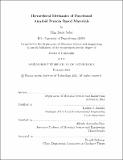Hierarchical mechanics of functional amyloid protein based materials
Author(s)
Solar, Max Isaac
DownloadFull printable version (45.86Mb)
Other Contributors
Massachusetts Institute of Technology. Department of Materials Science and Engineering.
Advisor
Markus J. Buehler.
Terms of use
Metadata
Show full item recordAbstract
Amyloid and amyloid-like proteins are a broad class of misfolded protein structures known for their their roles in a variety of neurodegenerative diseases, but also for their impressive mechanical properties and their propensity to self-assemble at diverse length scales. These properties make amyloid and amyloid-like proteins excellent candidate materials for the design of engineered functional biomaterials. However, many of the fundamental structure-property relationships which could guide the design of amyloid-based functional materials for various applications are not well understood. In this thesis, a multiscale modeling and simulation approach is used to investigate these structure-property relationships at multiple length scales. Full atomistic simulations are used to study the tensile and bending response of single fibrils, as well as the inter-fibril interaction strength. It is found that in tension, the specific geometry of the fibrils does not significantly influence the deformation behavior, but the mechanical properties, most notably the tensile strength, depends strongly on the areal density of hydrogen bonds in the fibril cross-section. The mechanical response at the molecular scale is used to guide the development of a coarse-grained description of amyloid and amyloid-like fibrils. Next, the adhesive behavior of amorphous polymers is studied to identify design principles which enhance adhesive performance and could be applied to aid in the design of amyloid-based adhesives, an exciting potential functional role for amyloid-based biomaterials. Finally, mesoscale structures are investigated including a nanowire-like geometry and adhesive films. These studies demonstrate that the mechanics of larger scale amyloid based structures are largely determined by the inter-fibril interactions; the specific intra-fibril properties become less significant at larger scales. The results presented in this thesis form the foundation for the development of basic materials selection criteria to aid in the design of functional amyloid-based biomaterials for diverse applications.
Description
Thesis: Ph. D., Massachusetts Institute of Technology, Department of Materials Science and Engineering, 2015. This electronic version was submitted by the student author. The certified thesis is available in the Institute Archives and Special Collections. Cataloged from student-submitted PDF version of thesis. Includes bibliographical references (pages 165-177).
Date issued
2015Department
Massachusetts Institute of Technology. Department of Materials Science and EngineeringPublisher
Massachusetts Institute of Technology
Keywords
Materials Science and Engineering.